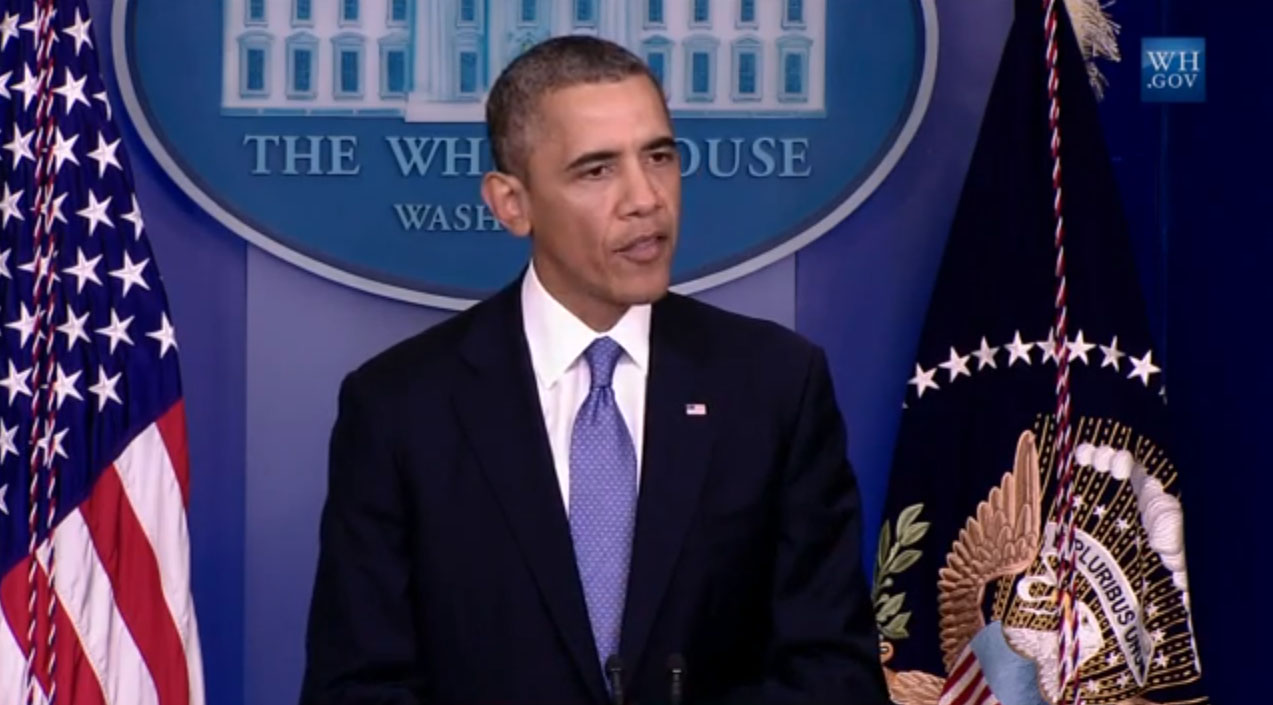Government Shutdown Would Ground NASA 'Almost Entirely,' Obama Says

Editor's Update (Oct. 17): NASA is officially reopened for business after a late-night Congress vote ended a two-week government shutdown. Full story: NASA Back Online After Government Shutdown Ends
NASA would be among those federal government agencies to experience a near total closure if the threatened government shutdown becomes reality on Oct. 1, U.S. President Barack Obama said Monday (Sept. 30). But a government shutdown should not endanger American astronauts currently in space.
"NASA will shut down almost entirely, but Mission Control will remain open to support the astronauts serving on the space station," Obama said during a statement delivered from the White House.
There are currently two NASA astronauts living on the International Space Station. Veteran astronaut Karen Nyberg has been living on the station since May and is midway through a months-long spaceflight. First-time space traveler Mike Hopkins, meanwhile, launched into space on Sept. 25 to begin his six-month stay.
Nyberg and Hopkins are two of six crewmembers on the space station's current Expedition 37 crew. Italian astronaut Luca Parmitano and Russian cosmonauts Fyodor Yurchikhin, Oleg Kotov and Sergey Ryazanskiy. [Amazing Space Photos by Astronaut Karen Nyberg]
A government shutdown would begin on Tuesday (Oct. 1) if Congress fails to fund the federal government beyond the end of the current fiscal year, which ends today.
NASA's government shutdown plan was released on Friday (Sept. 27). That plan includes closing down the majority of its operations and placing most if its thousands-strong workforce on furlough.
Get the Space.com Newsletter
Breaking space news, the latest updates on rocket launches, skywatching events and more!
Less than 600 of the space agency's 18,000 employees will continue working if a government shutdown does occur, NASA officials explained in the plan submitted to the Office of Management and Budget.
"To protect the life of the crew as well as the assets themselves, we would continue to support planned operations of the ISS [space station] during any funding hiatus," the NASA plan states. "Moreover, NASA will be closely monitoring the impact of an extended shutdown to determine if crew transportation or cargo resupply services are required to mitigate imminent threats to life and property on the ISS or other areas."
According to the plan, satellites and spacecraft currently in space will be maintained, though measurements, amazing photos and other data will have to be safeguarded for the duration of the shutdown. But spacecraft and satellites that have not yet been launched would likely be grounded or have work stop on those projects.
"The extent of support necessary and the time needed to safely cease project activities will depend on whether any of the activities are of a hazardous nature (e.g., parts of the satellite may need to be cooled)," NASA's shutdown plan states.
NASA currently has a fleet of active spacecraft and rovers exploring different parts of the solar system and beyond. Many satellites are orbiting the Earth to study our home planet, while other probes orbit the moon, Mercury, Mars and Saturn. NASA's Mars rover Curiosity and the smaller Opportunity rover are driving across the Martian surface.
Still more spacecraft, like the Hubble Space Telescope and Spitzer Space Telescope, are peering deep into the universe, while other observatories, like the Solar Dynamics Observatory, study the sun.
Other spacecraft are simply in transit, in the gulf between planets. NASA's New Horizons spacecraft is streaking through the outer solar system for a planned July 2015 flyby of Pluto. It launched in 2006.
NASA's Juno spacecraft, meanwhile, has covered half of the distance it will travel on its mission to Jupiter. The probe launched in August 2011 and is expected to fly by Earth on Oct. 9 to grab a speed boost for the rest of its journey to Jupiter. Juno is due to arrive at Jupiter in July 2016 to study the planet in unprecedented detail.
And then there is Voyager 1, the farthest manmade spacecraft in history. Voyager 1 is hurtling through interstellar space far from the political squabbles surrounding Tuesday's looming government shutdown. It entered interstellar space in August 2012 and is now 11.7 billion miles (18.8 billion kilometers) from Earth.
You can read more about NASA's government-shutdown plan here:
http://www.nasa.gov/news/budget/index.html
Email Tariq Malik at tmalik@space.com or follow him @tariqjmalikand Google+. Follow us @Spacedotcom, Facebook and Google+. Original article on SPACE.com.
Join our Space Forums to keep talking space on the latest missions, night sky and more! And if you have a news tip, correction or comment, let us know at: community@space.com.

Tariq is the Editor-in-Chief of Space.com and joined the team in 2001, first as an intern and staff writer, and later as an editor. He covers human spaceflight, exploration and space science, as well as skywatching and entertainment. He became Space.com's Managing Editor in 2009 and Editor-in-Chief in 2019. Before joining Space.com, Tariq was a staff reporter for The Los Angeles Times covering education and city beats in La Habra, Fullerton and Huntington Beach. In October 2022, Tariq received the Harry Kolcum Award for excellence in space reporting from the National Space Club Florida Committee. He is also an Eagle Scout (yes, he has the Space Exploration merit badge) and went to Space Camp four times as a kid and a fifth time as an adult. He has journalism degrees from the University of Southern California and New York University. You can find Tariq at Space.com and as the co-host to the This Week In Space podcast with space historian Rod Pyle on the TWiT network. To see his latest project, you can follow Tariq on Twitter @tariqjmalik.